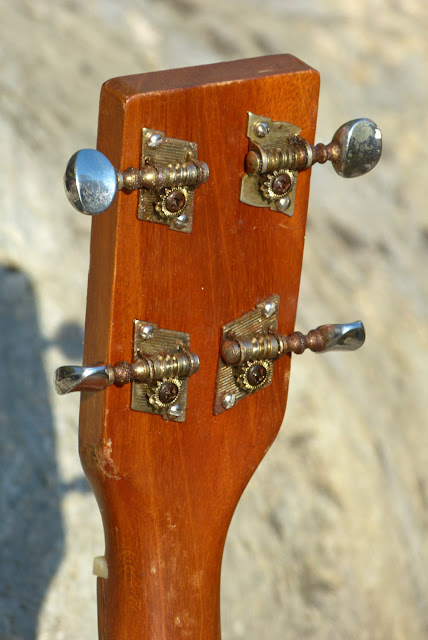1960s Harmony Baritone Ukulele
Pretty mahogany, right? These old Harmony baris don't really get enough credit in the modern market, but they're quite good instruments for their cost, and often look the business, too. This one has some nice figure in the mahogany that just pops in the sun.
I bought this for my father-in-law, who wants to play uke but did not like the spacing of smaller ukes. Baritones have a guitar-player-friendly 19" scale and, provided you use the right strings, can be pitched in the same range as a regular soprano/concert/tenor uke -- which I've done, here, save that the G string is "low G" instead of re-entrant. I used an Aquila 5-string banjo nylgut set for the job (minus the drone string) and it works just fine with no wound strings.
All I needed to do on this uke was cleat/fill one tight hairline on the top, lower the saddle just a hair, and give the frets a very light level/dress job. I also swapped the tuners to guitar-style ones, too. Often I'll need to shave the bridge a bit on these but, thankfully, the neck/bridge angles on this were almost perfect.
I added side dots, too.
The bridge and fretboard are Brazilian rosewood and the nut and saddle are plastic. In the 60s (and very late 50s), Harmony started going to plastic instead of the bone they'd used previously. The bodies also seemed to get a little thicker and the tone a bit more muted. This one, however, has a pretty good sound for its 60s build.
The parts-bin Japanese tuners were, clearly, "good enough for government work."
I'm always a fan of tortoise trim on a mahogany instrument.















Comments
Sorry to bother you, but I had a few questions about my Harmony baritone ukulele which just came in the mail today. I do not have a year or model number on it since it has no tag inside, and the only other markings it has is "Harmony" on the headstock, with the musical note between the four pegheads, and below then note, "Made in the USA" below it (see photos). I clicked on your museum page to see all your baritone ukes, and body-wise, it is the same as your 1960s model, down to the tortoise shell binding and headstock shape. But, I cannot find a photo of my copy online! I found pretty much all of your variations, even the Silvertones, but no Harmony ukes with the musical note. I know that some baritones were made later on, and I even saw the 1980s versions, but mine isn't like those. Those have screws into the bridge where mine is glued to the soundboard instead. Anywhere I can search? Thank you for your time :)
Jack Patino
P.S. I am going to leave this same message with your email listed above, just in case you see that message before this. At least there, I can send photos :) If you message me back, please use prodigy.net email address I sent you; I rarely use my gmail.com address but I will keep a look out for your reply either way. Thanks again!
Thanks , Dean
1950s ones have the old-style logo and generally have bone saddles and nuts. Very late '50s models have the old logo and plastic saddle/nut. The finish on '50s models tends to be a little thinner and duller and the wood quality is a little nicer/more even.
The very earliest Harmony baritones are like the '50s models but have an even lighter build and closer attention to detail on the insides RE bracing and glue-gum-up. I know this is all very subjective, but this is what I've seen "in the field."